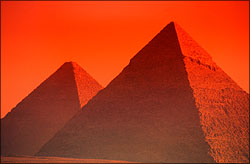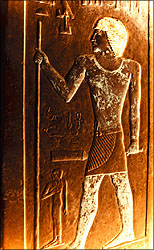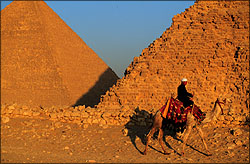
|
Ancient Egypt
 There are days when the sand blows ceaselessly, blanketing the remains
of a powerful dynasty that ruled Egypt 5,000 years ago. When the wind dies
down and the sands are still, a long shadow casts a wedge of darkness across
the Sahara, creeping ever longer as the north African sun sinks beyond the
horizon. This is where our history of Egypt begins, in the shadow of the Great
Pyramid of Giza, where stone meets sky as a testament to one of the greatest
civilizations on earth. Here, on the plateau of Giza, 2,300,000 blocks of
stone, some weighing as much as 9 tons, were used to build an eternal tomb for
a divine king. There are days when the sand blows ceaselessly, blanketing the remains
of a powerful dynasty that ruled Egypt 5,000 years ago. When the wind dies
down and the sands are still, a long shadow casts a wedge of darkness across
the Sahara, creeping ever longer as the north African sun sinks beyond the
horizon. This is where our history of Egypt begins, in the shadow of the Great
Pyramid of Giza, where stone meets sky as a testament to one of the greatest
civilizations on earth. Here, on the plateau of Giza, 2,300,000 blocks of
stone, some weighing as much as 9 tons, were used to build an eternal tomb for
a divine king.
 Five thousand years ago, the fourth dynasty of Egypt's Old Kingdom was a highly
advanced civilization where the kings, known as pharaohs, were believed to be
gods. They lived amidst palaces and temples built to honor them and their
deified ancestors. "Pharaoh" originally meant "great house," but later came to
mean king. What we know of this early society changes and is re-intepreted
year by year as new archaeological finds discovered beneath the desert sands
revise our understanding of ancient Egypt. This web site will show you science
in action—bringing you face to face with the evidence archaeologists use to
understand the meaning of Giza's pyramids, and to the process of evaluating the
finds they will uncover beneath the sands of the plateau. Five thousand years ago, the fourth dynasty of Egypt's Old Kingdom was a highly
advanced civilization where the kings, known as pharaohs, were believed to be
gods. They lived amidst palaces and temples built to honor them and their
deified ancestors. "Pharaoh" originally meant "great house," but later came to
mean king. What we know of this early society changes and is re-intepreted
year by year as new archaeological finds discovered beneath the desert sands
revise our understanding of ancient Egypt. This web site will show you science
in action—bringing you face to face with the evidence archaeologists use to
understand the meaning of Giza's pyramids, and to the process of evaluating the
finds they will uncover beneath the sands of the plateau.
 Before looking closely at pharaonic society and the beginning of the Pyramid
Age, one first has to step into Egypt's landscape and take a look around.
Ancient Egyptians called their land "Kemet," which meant "black," after the
black fertile silt-layered soil that was left behind each year during the
annual innundation, when the Nile flooded the fields. The most prevalent color
of the desert, however, is a decidedly reddish-yellow ochre. The Egyptians
called the desert "deshret," meaning "red," and this endless carpet of sand
covers an estimated 95 % of Egypt, interrupted only by the narrow band of green
carved by the waters of the Nile. Here, the extreme dry sands of the desert
meet the fertile silt-laden soils along the Nile—a river that provides a
source of life for the entire nation and a good part of the African continent. Before looking closely at pharaonic society and the beginning of the Pyramid
Age, one first has to step into Egypt's landscape and take a look around.
Ancient Egyptians called their land "Kemet," which meant "black," after the
black fertile silt-layered soil that was left behind each year during the
annual innundation, when the Nile flooded the fields. The most prevalent color
of the desert, however, is a decidedly reddish-yellow ochre. The Egyptians
called the desert "deshret," meaning "red," and this endless carpet of sand
covers an estimated 95 % of Egypt, interrupted only by the narrow band of green
carved by the waters of the Nile. Here, the extreme dry sands of the desert
meet the fertile silt-laden soils along the Nile—a river that provides a
source of life for the entire nation and a good part of the African continent.
(continued)
Photos: Aaron Strong
Pyramids Home | Pyramids | Excavation
Contents | Mail
|